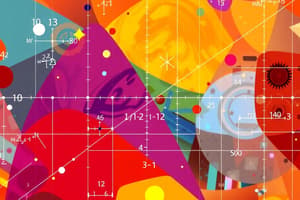Podcast
Questions and Answers
What is a necessary condition for a function to be classified as a linear transformation?
What is a necessary condition for a function to be classified as a linear transformation?
- It must combine vector addition and scalar multiplication in a way that is independent of the field.
- It can only apply to finite-dimensional vector spaces.
- It must satisfy the property that $T(\alpha u) = \alpha T(u)$ for all scalars $\alpha$. (correct)
- It must map vectors from one vector space to another without changing their structure.
Which property characterizes the kernel of a linear transformation?
Which property characterizes the kernel of a linear transformation?
- It includes all vectors that map to the zero vector in the codomain. (correct)
- It contains all images of vectors in the range.
- It consists only of the zero vector from the domain.
- It is equivalent to the rank of the transformation.
What does the Rank Nullity Theorem state?
What does the Rank Nullity Theorem state?
- The sum of the rank and nullity of a linear operator equals the dimension of the domain. (correct)
- Both the rank and nullity must always be zero for linear transformations.
- The nullity of a transformation must be greater than its rank.
- The rank and nullity can be equal for certain transformations.
In the context of vector spaces, what is an isomorphism?
In the context of vector spaces, what is an isomorphism?
If two vector spaces are isomorphic, what can be concluded about their dimensions?
If two vector spaces are isomorphic, what can be concluded about their dimensions?
Which of the following expressions is consistent with the linearity of a transformation?
Which of the following expressions is consistent with the linearity of a transformation?
Which statement is true regarding the mapping $f: R^2 → R^3 | f(x, y) = (x, y, 0)$?
Which statement is true regarding the mapping $f: R^2 → R^3 | f(x, y) = (x, y, 0)$?
What does the Fundamental Theorem of Homomorphism relate to in linear transformations?
What does the Fundamental Theorem of Homomorphism relate to in linear transformations?
What does the linear combination of column vectors involve?
What does the linear combination of column vectors involve?
If vectors 𝑢, 𝑣, 𝑤, 𝑧 in four-dimensional space are combined, what is a possible outcome?
If vectors 𝑢, 𝑣, 𝑤, 𝑧 in four-dimensional space are combined, what is a possible outcome?
What is a key outcome of the linear combination of an equal number of scalars and vectors?
What is a key outcome of the linear combination of an equal number of scalars and vectors?
What defines the finite dimension of a vector space?
What defines the finite dimension of a vector space?
What is meant by the 'consistency of a system' in linear algebra?
What is meant by the 'consistency of a system' in linear algebra?
What is the primary focus of the course MTH212 Linear Algebra?
What is the primary focus of the course MTH212 Linear Algebra?
How many units are there in the course MTH212 Linear Algebra?
How many units are there in the course MTH212 Linear Algebra?
Which of the following topics are NOT covered in MTH212 Linear Algebra?
Which of the following topics are NOT covered in MTH212 Linear Algebra?
What is the required study time for the MTH212 Linear Algebra course?
What is the required study time for the MTH212 Linear Algebra course?
In which module are linear combinations covered in MTH212 Linear Algebra?
In which module are linear combinations covered in MTH212 Linear Algebra?
What type of communication can students expect with facilitators in the MTH212 course?
What type of communication can students expect with facilitators in the MTH212 course?
Which module includes 'Characteristic and Minimal Polynomials'?
Which module includes 'Characteristic and Minimal Polynomials'?
What is one of the attributes of the materials used in MTH212 Linear Algebra?
What is one of the attributes of the materials used in MTH212 Linear Algebra?
What does the term 'linear combination' refer to in linear algebra?
What does the term 'linear combination' refer to in linear algebra?
Given the scalars 𝛽1 = 2, 𝛽2 = -1, 𝛽3 = -3, and 𝛽4 = 0, what is the correct result of the linear combination with vectors u1, u2, u3, and u4?
Given the scalars 𝛽1 = 2, 𝛽2 = -1, 𝛽3 = -3, and 𝛽4 = 0, what is the correct result of the linear combination with vectors u1, u2, u3, and u4?
In the context of systems of equations, what does it mean for a system to be consistent?
In the context of systems of equations, what does it mean for a system to be consistent?
Which of the following statements is true regarding the vector B and the matrix A in the equation Ax = B?
Which of the following statements is true regarding the vector B and the matrix A in the equation Ax = B?
What is the resulting vector when applying the linear combination using the scalars 𝛼1 = -1, 𝛼2 = -3, 𝛼3 = 4, and 𝛼4 = 2 on vectors u1, u2, u3, and u4?
What is the resulting vector when applying the linear combination using the scalars 𝛼1 = -1, 𝛼2 = -3, 𝛼3 = 4, and 𝛼4 = 2 on vectors u1, u2, u3, and u4?
Which of the following scalars would definitely lead to an inconsistent system when creating a linear combination with vectors?
Which of the following scalars would definitely lead to an inconsistent system when creating a linear combination with vectors?
If you have the equation Ax = B, which condition indicates that B is NOT a linear combination of the columns of A?
If you have the equation Ax = B, which condition indicates that B is NOT a linear combination of the columns of A?
What defines a linear combination of the vectors u1, u2, u3, and u4?
What defines a linear combination of the vectors u1, u2, u3, and u4?
What does the expression $\alpha \cdot (\beta \cdot u)$ equal according to the properties of vector spaces?
What does the expression $\alpha \cdot (\beta \cdot u)$ equal according to the properties of vector spaces?
Which statement correctly applies the distributive property of scalar multiplication over vector addition?
Which statement correctly applies the distributive property of scalar multiplication over vector addition?
In vector operations, what is the result of $1 \cdot u$?
In vector operations, what is the result of $1 \cdot u$?
Which of the following represents the correct way to add two vectors in algebraic form?
Which of the following represents the correct way to add two vectors in algebraic form?
What is the geometric interpretation of scalar multiplication by a negative value?
What is the geometric interpretation of scalar multiplication by a negative value?
What property is illustrated by the equation $\alpha \cdot (u + v) = \alpha u + \alpha v$?
What property is illustrated by the equation $\alpha \cdot (u + v) = \alpha u + \alpha v$?
Which of the following statements is true about the operation of addition in vector spaces?
Which of the following statements is true about the operation of addition in vector spaces?
What is the associative property of scalar multiplication as given in the content?
What is the associative property of scalar multiplication as given in the content?
What does Theorem 3.1 state about a linear transformation T with respect to a basis of U?
What does Theorem 3.1 state about a linear transformation T with respect to a basis of U?
In the context of Theorem 3.2, which statement is true about the linear transformation T: R → V?
In the context of Theorem 3.2, which statement is true about the linear transformation T: R → V?
How does Theorem 3.3 relate to the linear transformation T and its basis vectors?
How does Theorem 3.3 relate to the linear transformation T and its basis vectors?
What is required for a vector u in U to be expressible in terms of a basis (e1, ..., en)?
What is required for a vector u in U to be expressible in terms of a basis (e1, ..., en)?
Which of the following is true regarding the operation of the linear transformation T based on Theorem 3.3?
Which of the following is true regarding the operation of the linear transformation T based on Theorem 3.3?
What is the significance of defining T(u) = α1v1 + ... + αnvn in Theorem 3.3?
What is the significance of defining T(u) = α1v1 + ... + αnvn in Theorem 3.3?
In the proof regarding T(3,5) based on the provided examples, what approach is taken to find T for any vector?
In the proof regarding T(3,5) based on the provided examples, what approach is taken to find T for any vector?
What is an essential property of linear transformations stressed in the document?
What is an essential property of linear transformations stressed in the document?
Flashcards
Vector Space
Vector Space
A set of vectors that can be added together and multiplied by scalars to form new vectors within the same set.
Linear Combination
Linear Combination
A linear combination of vectors is a sum of scalar multiples of those vectors.
Linear Transformation
Linear Transformation
A function that maps vectors from one vector space to another, preserving addition and scalar multiplication.
Matrix
Matrix
Signup and view all the flashcards
Eigenvalue
Eigenvalue
Signup and view all the flashcards
Eigenvector
Eigenvector
Signup and view all the flashcards
Determinant
Determinant
Signup and view all the flashcards
Characteristic Polynomial
Characteristic Polynomial
Signup and view all the flashcards
Linear Combination of Column Vectors
Linear Combination of Column Vectors
Signup and view all the flashcards
Finite Dimension of a Vector Space
Finite Dimension of a Vector Space
Signup and view all the flashcards
Consistency of a System
Consistency of a System
Signup and view all the flashcards
Linear Span of a Collection of Vectors
Linear Span of a Collection of Vectors
Signup and view all the flashcards
Solving a System Containing a Linear Combination of Columns
Solving a System Containing a Linear Combination of Columns
Signup and view all the flashcards
Solution to a System of Equations
Solution to a System of Equations
Signup and view all the flashcards
Consistent and Inconsistent System
Consistent and Inconsistent System
Signup and view all the flashcards
Linear Combination and Consistency
Linear Combination and Consistency
Signup and view all the flashcards
Associativity of Scalar Multiplication
Associativity of Scalar Multiplication
Signup and view all the flashcards
Distributivity across Vector Addition
Distributivity across Vector Addition
Signup and view all the flashcards
Distributivity across Scalar Addition
Distributivity across Scalar Addition
Signup and view all the flashcards
Multiplicative Identity
Multiplicative Identity
Signup and view all the flashcards
Vector Space Definition
Vector Space Definition
Signup and view all the flashcards
The Algebraic Definition of a Vector
The Algebraic Definition of a Vector
Signup and view all the flashcards
Euclidean Plane as a Vector Space
Euclidean Plane as a Vector Space
Signup and view all the flashcards
n-Tuples as Vector Spaces
n-Tuples as Vector Spaces
Signup and view all the flashcards
What is a Linear Transformation?
What is a Linear Transformation?
Signup and view all the flashcards
What's the Range of a Linear Transformation?
What's the Range of a Linear Transformation?
Signup and view all the flashcards
What's the Kernel of a Linear Transformation?
What's the Kernel of a Linear Transformation?
Signup and view all the flashcards
What is Rank in Linear Transformations?
What is Rank in Linear Transformations?
Signup and view all the flashcards
What is Nullity in Linear Transformations?
What is Nullity in Linear Transformations?
Signup and view all the flashcards
What is the Rank-Nullity Theorem?
What is the Rank-Nullity Theorem?
Signup and view all the flashcards
What is an Isomorphism between Vector Spaces?
What is an Isomorphism between Vector Spaces?
Signup and view all the flashcards
What is the Relationship between Isomorphism and Dimension?
What is the Relationship between Isomorphism and Dimension?
Signup and view all the flashcards
Theorem 3.1: Linear Transformation Determined by Values on Basis
Theorem 3.1: Linear Transformation Determined by Values on Basis
Signup and view all the flashcards
Theorem 3.2: Linear Transformation from R to V
Theorem 3.2: Linear Transformation from R to V
Signup and view all the flashcards
Theorem 3.3: Existence and Uniqueness of Linear Transformation
Theorem 3.3: Existence and Uniqueness of Linear Transformation
Signup and view all the flashcards
Linear Transformation: Closure under Linear Combinations
Linear Transformation: Closure under Linear Combinations
Signup and view all the flashcards
Consistency of a System of Equations
Consistency of a System of Equations
Signup and view all the flashcards
Study Notes
Course Information
- Course Code: MTH212
- Course Title: Linear Algebra
- Credit Units: 3
- Course Status: Compulsory
- Course Description: Basic course covering fundamental linear algebra concepts, suitable for self-study, online programs
- Topics Covered: Vector spaces, linear maps/transformations, matrices, determinants, eigenvalues, and eigenvectors
- Semester: Second Semester
- Course Duration: 13 Weeks
- Required Study Hours: 91 hours
24/7 Support
- Communication: 24/7 email contact with facilitator and study center, response within 24 hours
- Support: Guidance, feedback on assessments/progress, and help resolving study challenges
Module Breakdown
-
Module 1: Vector Spaces
- Unit 1: Vector Spaces: Defining fundamental vector space properties
- Unit 2: Linear Combinations: Combining vectors using scalars
- Unit 3: Linear Transformations I: Introduction to linear transformations
- Unit 4: Linear Transformations II: Further concepts related to linear transformations
-
Module 2: Matrices
- Unit 1: Matrices I: Introduction to Matrices
- Unit 2: Matrices II: More matrix concepts
- Unit 3: Matrices III: Advanced matrix topics
-
Module 3: Determinants
- Unit 1: Determinants I: Foundational concepts in determinants
- Unit 2: Determinants II: More advanced topics on determinants
-
Module 4: Eigenvalues and Eigenvectors
- Unit 1: Eigenvalues and Eigenvectors: Defining eigenvalues and eigenvectors
- Unit 2: Characteristic and Minimal Polynomials: Examining characteristic and minimal polynomials
Vector Spaces (Detailed)
-
Definition: Mathematical object that expresses relationships among elements within the vector space
-
Properties:
- Distributivity across vector addition, scalar multiplication
- Scalar Multiplication (scalar * vector = vector)
- Scalar addition (scalar1 + scalar2) * vector = (scalar1 * vector) + (scalar2 * vector)
- 1 * vector = vector
-
Examples:
- Euclidean Plane (R²): Geometrically, an arrow representing a vector from origin; algebraically, ordered pairs (x,y) of real numbers
- n-tuple (Fⁿ): Ordered n-tuples of elements from a field F
Linear Combinations
- Definition: Combining multiple vectors using scalars (multipliers)
- Methods: Generating various linear combinations by changing the scalars, resulting in different vector outputs
- Consistency: A system's solution existence or non-existence
Linear Transformations
- Definition: Function between vector spaces respecting vector addition and scalar multiplication
- Properties: Preserves vector addition (linear transformation of a sum is sum of linear transformations) and scalar multiplication (linear transformation of a scalar multiple is scalar times linear transformation)
Studying That Suits You
Use AI to generate personalized quizzes and flashcards to suit your learning preferences.




